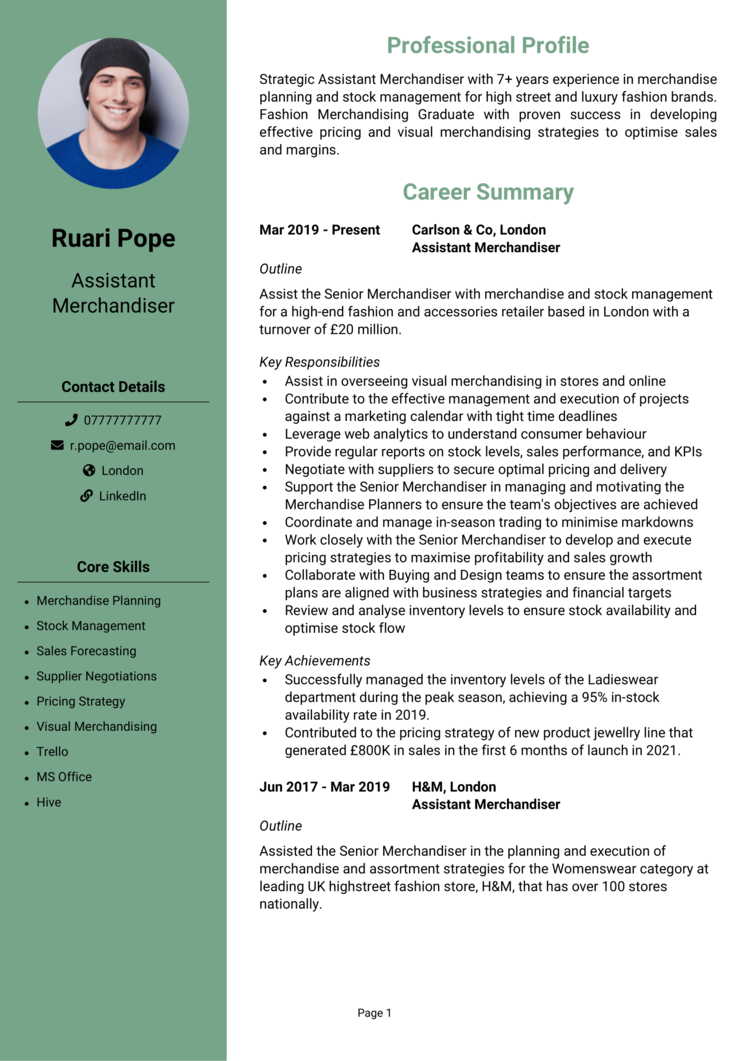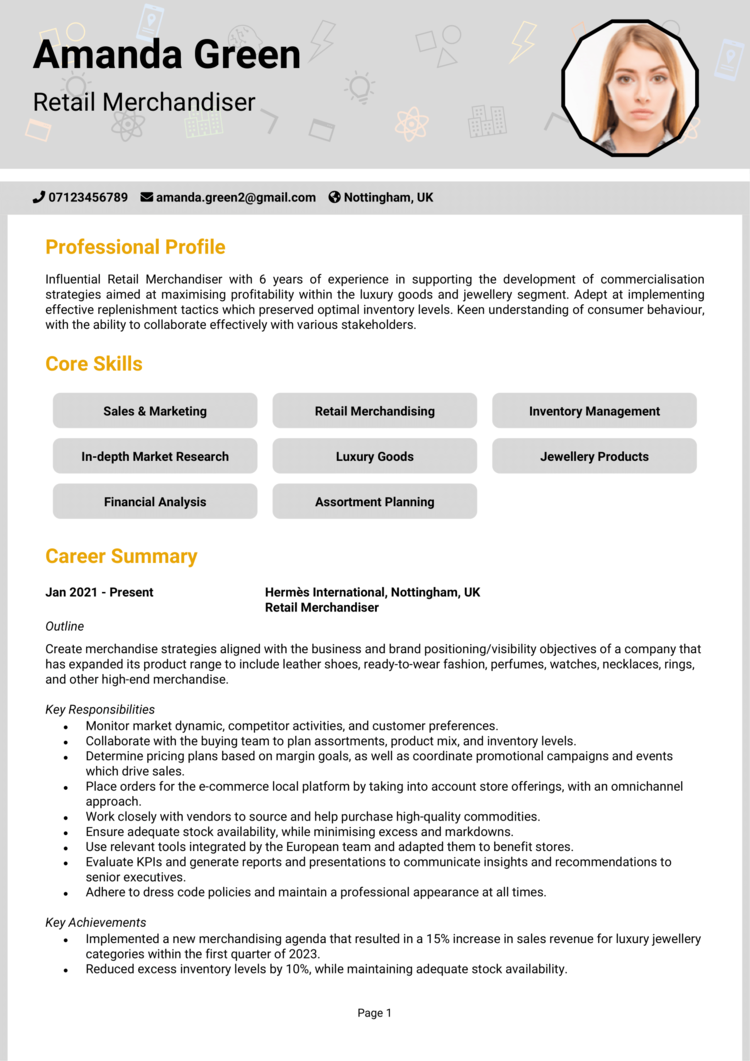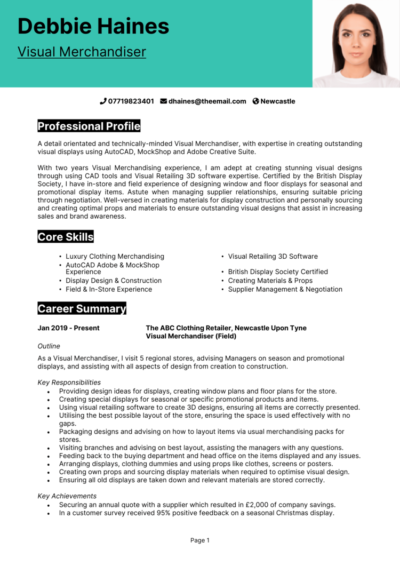You know how to catch a shopper’s eye from across the room – but now it’s time to do the same for a recruiter. As a Visual Merchandiser, your CV needs to reflect that same balance of flair and function.
This guide (with 4 Visual Merchandiser example CVs) will help you design a compelling, professional CV that showcases your eye for aesthetics and your real impact on sales.
Visual Merchandiser CV

Assistant Merchandiser CV

Fashion Merchandiser CV

Retail Merchandiser CV

How to write your Visual Merchandiser CV
Discover how to craft a winning Visual Merchandiser CV that lands interviews with this simple step-by-step guide.
The best displays tell a story – and so should your CV. Whether you’ve styled windows for a flagship store or transformed seasonal layouts to boost footfall, this is your chance to present your skills in a clean, cohesive format.
In the next few sections, you’ll be writing a CV which structures your experience, highlight your creativity, and tailor your application to retail brands looking for someone with an eye for both design and results.
How to structure and format your Visual Merchandiser CV


In retail, presentation is everything – and the same applies to your CVs structure. Employers want to quickly see your experience, your creative strengths, and how your work drives customer engagement and sales performance.
Here’s how your CV should be laid out:
- Name and contact details – Keep these personal info at the top so a potential employer can reach out to you.
- Profile – Immediately draw in the recruiter with a brief summary of your skills and experience.
- Core skills – Quickly bullet point to highlight technical and creative abilities.
- Work experience – List your previous roles starting with the most recent, and show how your designs made an impact.
- Education & certifications – Go through qualifications related to fashion, design, or retail, like degrees and certificates.
- Additional info – You can optionally list any relevant hobbies and interests, and awards which help to convey your suitability.
Keep your formatting polished and concise: use a clear, professional font, divide each section with clean headings, present details in bullet points where appropriate, and keep your CV length under two pages: save any more for a CV cover letter. Following these simple formatting tips will keep the focus on your expertise, not your mistakes.
How to write a Visual Merchandiser CV profile


This brief introduction is your chance to showcase both your creative flair and commercial focus. It should immediately communicate your experience and the strengths that make you a standout visual merchandiser. You need to convey your value to recruiters, and your CV profile is the perfect way to do this quickly.
Visual Merchandiser CV profile examples
Profile 1
Creative and detail-focused Visual Merchandiser with over five years of experience designing and implementing in-store displays for fashion and lifestyle retailers. Skilled in layout planning, seasonal styling, and brand presentation. Adept at translating marketing campaigns into visually impactful spaces that drive customer engagement and increase sales. Proficient in using planograms and working within brand guidelines.
Profile 2
Experienced Visual Merchandiser with four years of hands-on experience across high street and department store settings. Specialises in window displays, promotional set-ups, and product placement strategies. Strong understanding of consumer behaviour and visual storytelling. Collaborative team player with a keen eye for colour, balance, and aesthetics.
Profile 3
Resourceful Visual Merchandiser with six years of experience enhancing customer experience through innovative in-store design. Skilled in using sales data to influence product placement, maximise floor space, and support promotional campaigns. Proficient in Adobe Creative Suite and visual merchandising software. Passionate about bringing brands to life through creative execution.
Details to put in your Visual Merchandiser CV profile
Here’s what to include:
- Where you’ve worked – Mention the brands or retailers you’ve supported, such as fashion chains, department stores, or high-street brands.
- Your top qualifications – Highlight any relevant certifications or diplomas in visual merchandising, design, or retail.
- Essential skills – Include strengths like spatial awareness, styling, trend interpretation, and planning displays.
- Experience with campaign and seasonal rollouts – Show you’ve executed visual plans for promotions or new collections.
- Ability to work cross-functionally with retail and marketing teams – Emphasise collaboration with store managers and head office departments.
What to include in the core skills section of your CV


Your CV skills section should be sharp and tailored to the job. This is where you show recruiters that you’ve got the creative instincts and the commercial understanding to boost foot traffic and maximise product visibility.
Stick to skills that reflect your strengths in planning, styling, display execution, retail strategy, and any relevant software. Use bullet points to make them instantly scannable.
What are the most important skills for a Visual Merchandiser CV?
- Store Layout Planning – Designing floor plans and display arrangements to optimise traffic flow and product visibility.
- Window and In-Store Display Design – Creating eye-catching visual presentations that attract customers and reflect brand identity.
- Trend Analysis and Styling – Researching current fashion and retail trends to inform display themes and seasonal updates.
- Product Placement Strategy – Positioning merchandise strategically to maximise sales and highlight key items or promotions.
- Brand Representation – Ensuring all visual displays align with brand guidelines, aesthetics, and messaging.
- Sales Data Interpretation – Analysing sales reports to understand product performance and adjust displays accordingly.
- Props and Materials Management – Sourcing, organising, and maintaining props, signage, and display materials.
- Collaboration with Retail Teams – Working with store managers and sales staff to implement displays and promotions.
- Lighting and Colour Theory Application – Using lighting, colour coordination, and composition to enhance visual appeal.
- Event and Campaign Execution – Setting up visual elements for new launches, seasonal campaigns, and in-store events.
How to write a strong work experience section for your CV


This section should show how you’ve used creativity and strategy to influence in-store experience and drive sales. Go beyond listing tasks – focus on your impact: increased customer engagement, improved product visibility, successful promotional rollouts, and so on.
List your roles in reverse order, starting with the most recent. Include store type and key responsibilities or campaign work that make you stand out. If possible, mention measurable outcomes (e.g. “contributed to 15% uplift in seasonal sales”).
The best way to structure job entries on your CV

- Outline – Briefly describe the company and store type, and your role within the visual merchandising team.
- Responsibilities – Describe core duties using action words like “styled,” “implemented,” “revamped,” or “collaborated.”
- Achievements – Highlight results like sales uplifts, successful campaign launches, or improved footfall.
Sample jobs for Visual Merchandiser
Visual Merchandiser | Aura Fashion Group
Outline
Managed visual merchandising for a leading UK fashion brand, designing window displays and in-store layouts to reflect seasonal trends and promotions.
Responsibilities
- Created window and interior displays in alignment with marketing campaigns and brand guidelines.
- Worked closely with store managers to implement floor moves and remerchandising strategies.
- Monitored weekly sales reports to optimise product placement and visual flow.
- Installed POS materials and signage during promotional events and product launches.
- Trained store staff on visual standards and seasonal styling updates.
Achievements
- Increased footfall by 22% through an innovative window display for the spring campaign.
- Reduced set-up time for seasonal floor changes by introducing visual planning templates.
- Recognised by head office for consistent execution and creative use of store layout.
Visual Merchandiser | Strata Department Stores
Outline
Oversaw visual displays for a multi-brand retail environment, ensuring consistent brand presentation and enhancing shopper experience.
Responsibilities
- Planned and executed daily and weekly visual updates across fashion, homeware, and beauty departments.
- Adapted merchandising strategies based on stock levels, store traffic, and sales insights.
- Collaborated with marketing and buying teams to align store visuals with current collections.
- Coordinated visual resets in line with promotional calendars and seasonal changes.
- Maintained display props, mannequins, and styling tools to ensure presentation standards.
Achievements
- Helped boost featured brand sales by 30% through strategic focal display placement.
- Improved cross-selling opportunities by introducing themed display zones.
- Received internal award for best execution of a nationwide seasonal campaign.
Visual Merchandiser | Northridge Home & Lifestyle
Outline
Delivered creative in-store merchandising solutions for a national homeware retailer, enhancing product visibility and driving customer engagement.
Responsibilities
- Designed store layouts and focal displays to reflect lifestyle themes and new product launches.
- Installed promotional signage and seasonal décor to support brand campaigns.
- Worked alongside sales teams to identify high-performing products and optimise visibility.
- Updated planograms and visual guides to reflect ongoing floor moves.
- Provided feedback to head office on store performance and customer response to displays.
Achievements
- Reduced excess stock by 18% through effective promotional product placement.
- Consistently exceeded visual merchandising audit targets across two store locations.
- Recognised by area management for creativity and attention to detail in VM execution.
How to list your educational history


While experience is key in visual merchandising, formal education and creative training can add a strong edge. Start with your most recent qualifications – whether in fashion, retail, design, or visual communication.
Also include any on-the-job training or short courses you’ve completed in areas like trend analysis, display design, or customer experience. Keep this part concise to make room for your work experience, which hiring managers value more.
What are the best qualifications for a Visual Merchandiser CV?
- Diploma in Visual Merchandising or Display Design – Industry-focused and creative.
- BTEC or HND in Fashion Retail or Art & Design – Great for those with a creative academic background.
- BA in Fashion Communication or Interior Design – Useful for concept-led merchandising.
- Retail Brand Training Courses – Often offered by larger retail employers for in-store execution.
- Adobe Creative Suite Training (InDesign, Photoshop) – Valuable for digital mock-ups and concept presentations.





